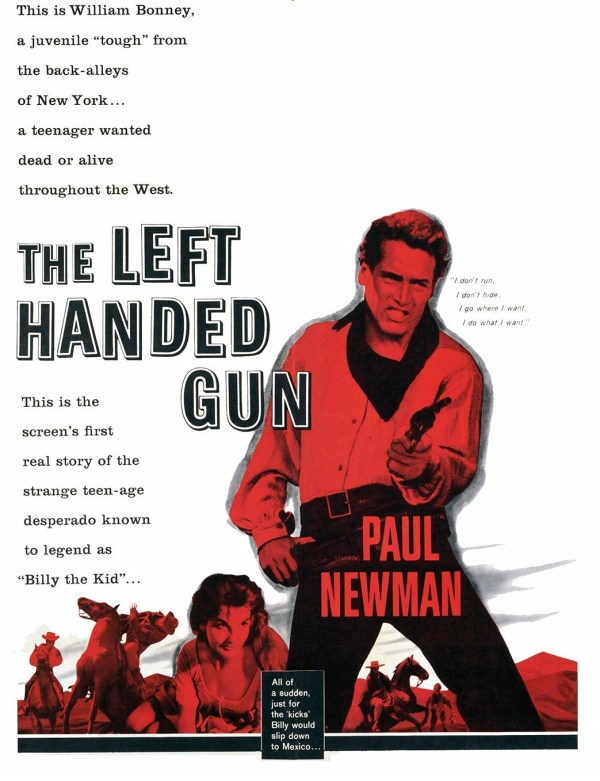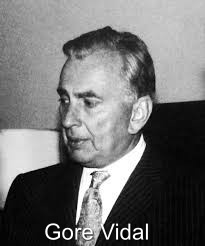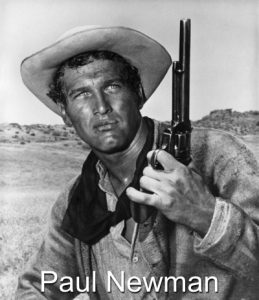THE American WESTERN
By Jeffrey-Baptiste Tarlofsky
By Jeffrey-Baptiste Tarlofsky
Lesson 15 consists of two video lectures and transcripts of those lectures, and one film excerpt. Start with the lecture, Part 1, and continue down the page in sequence until you reach the end of the lesson.
レッスン15は2本のビデオレクチャー(レクチャーのテキストがビデオレクチャーの下に記載されています)と1本の動画で構成されています。
このレッスンは、ページをスクロールダウンしながら最初から順番に動画を見たりテキストを読んでください。

Directed by: Arthur Penn
Produced by: Fred Coe
Screen play by: Leslie Stevens
Starring: Paul Newman, Lita Milan, John Dehner
Music by: Alexander Courage
Distributed by: Warner Bros.
Running time: 102 minutes
Part 1 – In John Ford’s Stagecoach when Ringo joins the people on the stagecoach, the banker Gatewood says, “So you’re the notorious Ringo Kid”, but Ringo explains that “Ringo” is just a nickname he had from childhood and his real name is Henry. He never accepts being called “The Kid”. “The Ringo Kid” is what others call him. “The Ringo Kid” is actually a combination of the names of two of the west’s most famous outlaws: Billy the Kid and Johnny Ringo. Neither of these men was anything like the good and honest Henry in Stagecoach. Neither Billy The Kid or Johnny Ringo were handsome or romantic heroes like Henry; they were both ruthless killers as well as outlaws. It is to Billy the Kid we now turn our attention.
Many books and films and even an opera have been made about Billy the Kid and he is one of the most legendary characters in the west. But there is so much myth surrounding his story that it is hard to keep track of the truth, which isn’t really very heroic or glamorous at all. First of all, “kid” is American slang, which is today still used to refer to children and young people in general. Even university students are sometimes called “college kids” and there is nothing offensive in using the word this way. It is a neutral term or sometimes a term of endearment.
However, in the Old West, “kid” was used to refer to a boy or young man (never a girl or young woman). It did not mean someone was an outlaw or gunfighter or gunslinger, but simply referred to someone who looked young. However, if a young man became famous as an outlaw or a gunfighter or a gunslinger, he might become known as the something or other “kid”.
William “Billy” Bonny began committing crimes at the age of fifteen and died when he was only twenty-one. He became known as “Billy the Kid”, a young man infamous for his many crimes. He has sometimes been called America’s first juvenile delinquent (juvenile = young, delinquent = prone to commuting crimes or bad acts).
Following the end of World War Two there was a marked increase in juvenile delinquency in America. The problem became something of an epidemic in the 1950s and as with all social problems it attracted the interest of intellectuals who tried to explain it. One of these was Gore Vidal. Vidal was a novelist, historian, journalist, sometime politician and one of America’s greatest pubic intellectuals. He created a largely fictional version of Billy that served as the basis for a film, The Left Handed Gun (1958), the focus of our class today.
The Left Handed Gun was the first film directed by Arthur Penn (1922-2010) who was part of what became known as “the Hollywood New Wave”. If John Ford and Howard Hawkes were directors who established the norms for the American Western, Arthur Penn was one of the directors who would go on to break those norms.

The Left Handed Gun was made in 1958, while the American Western was still at the peak of its popularity. Hollywood produced between four to five hundred movies per year in the 1950s; in the year 1958, forty-six of those films were Westerns. Westerns were the most popular genre of the 1950s, but like the rest of Hollywood, they were changing by the late 1950s. One way they changed was in how they depicted the problems of youth. According to encyclopedia.com, “In the 1940s and the early 1950s the American film industry generally presented teenagers as either miniature adults or children. It was in 1955, with the release of Blackboard Jungle and Rebel Without a Cause, that the teenage years began to be shown as a separate stage of life. Though the movies may claim some credit (or blame) for spreading this idea of the teenager, Hollywood films were largely reacting to a new youth culture made possible by a booming economy, technological advances (from inexpensive automobiles to the 45 rpm record player), and cultural blending (like the mixture of the popular music of both black and white culture, which produced rock and roll). Hollywood teenagers did not, however, fit into a narrow stereotype – they ranged from well-behaved rich kids (Bernardine, 1957) or surfers (Gidget, 1959) to troubled teens (East of Eden, 1955) and juvenile delinquents (Blackboard Jungle). The Billy the Kid depicted in The Left Handed Gun is one of these troubled teens
Let’s meet this troubled boy in the opening scene of Penn’s The Left Handed Gun.
Part 2 – Western films are a bit like kabuki dramas in that much older actors are frequently used to depict young characters. The thirty-one-year-old John Wayne depicted the Ringo Kid in Stagecoach and almost twenty years later a thirty-three-year-old Paul Newman depicts an approximately seventeen or eighteen-year-old Billy The Kid. Both actors don’t look remotely like teenagers, but they do act like teenagers and so their performances work.
The Left-handed Gun, like Red River, again presents us with an older man, John Tunstall, taking a teenage boy, William “Billy” Bonny, under his care and protection. There really was a John Tunstall who was an English born cattleman who challenged the power of the local ranchers in Lincoln County in the New Mexico territory.
However, the real John Tunstall was only twenty-four years old when he hired William Bonney to work for him. Why did Gore Vidal and Arthur Penn make him so much older in their film? We said that in Howard Hawkes Red River Tom is obviously a father figure for Matt even though he also takes Matt as his boy lover. I think Gore Vidal’s script places Tunstall in a similar father role to Tom’s, but no sexual aspect of the relationship is ever hinted at (perhaps because Billy and Tunstall only know each other for only a single day). Thirty years later, in the film Young Guns (1988), another telling of the Billy the Kid story, the bad guy in the film salaciously suggests that Tunstall hires handsome young cowboys like Billy because he wants to have them as lovers. That is an interesting example of a film director, Christopher Cain, mistakenly projecting the homophobia of the twentieth century onto a West that wasn’t nearly so homophobic. In the old west accusing a rancher of sleeping with his cowboys would have probably gotten a shrug and an answer of “So what?”.

To the American film audiences of 1958, it seemed very significant that Billy had no real father. Some people believed that the reason juvenile delinquency increased in the 1950s was because so many fathers had died in World War Two. U.S. casualties were over 400,000 killed and many of these men would have been the fathers of young people who would have become teenagers by the 1950s. One of the main themes in Western films after World War Two is the necessity of patriarchal (fatherly) authority in the American family. In this sense, Arthur Penn’s film is quite conventional. The film is somewhat unusual in focusing not on that patriarchal authority, but on what happens when it is absent. “Boys without fathers get into trouble” seems to be the message of the film.
Penn and Vidal also make a great deal of the fact that Billy was illiterate (could not read). Tunstall is a patriarchal figure in the film, but he is also like a teacher. Remember that this was a time in America when one of the main teaching tools in what few schools in the West there were, was the whip. Teachers were often feared and hated by students. But in the 1950s in America there was a movement for educational reform in the United States. Basically, there was an attempt made to improve the quality of the teachers responsible for the education of the nation’s young. More and better teacher training was required and some of the crueler and stupider practices were eliminated.
One popular new idea was to interest students in reading for pleasure. Books, it was thought, could be the key to keeping students interested in and motivated towards continuing to go to school. As anyone who reads books knows, reading is an escape from the boredom or unhappiness of daily life. For many teenagers any form of escape was preferable to their daily lives. It was known that teenagers who dropped out of school were far more likely to become juvenile delinquents than those who stayed in to graduate high school. If reading could help keep teenagers interested in school, it might keep them from turning to juvenile delinquency. Mr. Tunstall first interests Billy in reading and then promises to teach him to read.
After Tunstall’s murder, the rest of the film is concerned with Billy’s search for revenge and his descent into a life of crime and murder and his eventual and inevitable death at the hands of the lawman Pat Garret. The film is a tragedy and Vidal and Penn want us to believe the tragedy of Billy’s life could have been prevented if only Billy had had a good father and good teachers. He might never have become “Billy the Kid”. The Left Handed Gun is a film with a message about a problem in society, just as John Ford’s Stagecoach had been a film about the problems of social prejudice.